Blogger outreach is one of the most effective ways to earn high-quality backlinks in 2025.
It works by building real relationships with niche-relevant blogs instead of relying on automation or mass emails. This approach supports Google’s E-E-A-T guidelines and helps improve authority, rankings, and long-term SEO performance.
Unlike spammy link-building tactics, manual outreach focuses on quality over quantity. Personalized emails, relevant content offers, and long-term collaboration are key to success.
In this guide, you’ll learn 10 actionable blogger outreach tips that actually get results. From finding the right blogs to writing better pitches and tracking outcomes, every step is covered in a clear and practical way.
What is Blogger Outreach?
Blogger outreach is a link-building strategy that earns backlinks by forming relationships with niche-relevant bloggers through personalized outreach and content collaboration.
Instead of buying links or sending mass emails, this approach focuses on earning editorial placements by offering real value.
Manual blogger outreach creates authentic partnerships that support long-term SEO. It’s fully aligned with Google’s E-E-A-T guidelines and remains effective even in 2025’s AI-driven SEO landscape.
Key elements of blogger outreach include:
- Prospecting – Find blogs with engaged audiences, strong topical relevance, and editorial control
- Outreach – Send tailored emails that reference past posts and propose mutual value
- Collaboration – Offer guest posts, expert quotes, or original data in exchange for contextual backlinks
👉 Discover T-RANKS’ Blogger Outreach Service for Quality Link Placements
Why Blogger Outreach Matters
Blogger outreach matters because it builds SEO authority through natural, trusted links that follow Google’s rules.
This strategy creates relevant backlinks by connecting with real bloggers in your niche. These links improve your website’s visibility, rankings, and trust signals.
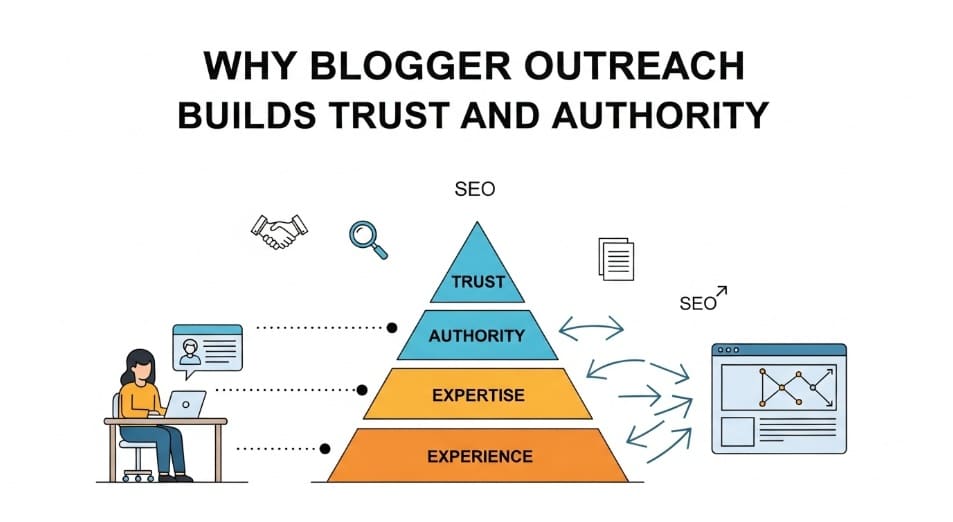
In 2025, Google continues to reward content backed by experience, expertise, authority, and trust. Blogger outreach supports all four. When done manually, it avoids risky link schemes and builds relationships that last.
This approach helps your brand earn placements on reputable websites. These backlinks pass link equity, boost topical relevance, and drive referral traffic from real audiences.
Trust and Authority: Blogger outreach aligns with Google’s E-E-A-T standards and supports long-term brand credibility.
Natural Backlinks: Links come from real content, not networks or shortcuts, which keeps your SEO profile clean.
Proven SEO Impact: T-RANKS outreach campaigns have increased client rankings by up to 20 percent with niche-relevant backlinks.
Boost your search visibility with T-RANKS’ proven blogger outreach strategies.
10 Blogger Outreach Tips
Effective blogger outreach starts with the right strategy, tools, and mindset.
If your goal is to earn high-quality backlinks, you need more than just emails. Successful outreach requires relevance, personalization, and value at every step.
In this section, you’ll learn ten proven blogger outreach tips that actually lead to backlinks. These are the same strategies used by top SEO professionals and digital PR teams to build authority in competitive niches.
Each tip is practical, easy to apply, and focused on long-term SEO gains.
Start implementing what works. These are the outreach strategies that get real results.
1. Identify Niche-Relevant Blogs
Niche relevance is the foundation of SEO trust and backlink value.
Google treats backlinks as votes of confidence. But not all votes carry equal weight. A backlink from a relevant site signals topical authority. A link from an unrelated blog looks artificial and may be ignored.
One of the most effective ways to find niche-relevant blogs is by analyzing your competitors. Start with your top 10 competitors. Use Ahrefs or Semrush to explore where they’re getting links—and which blogs consistently publish content in your space.
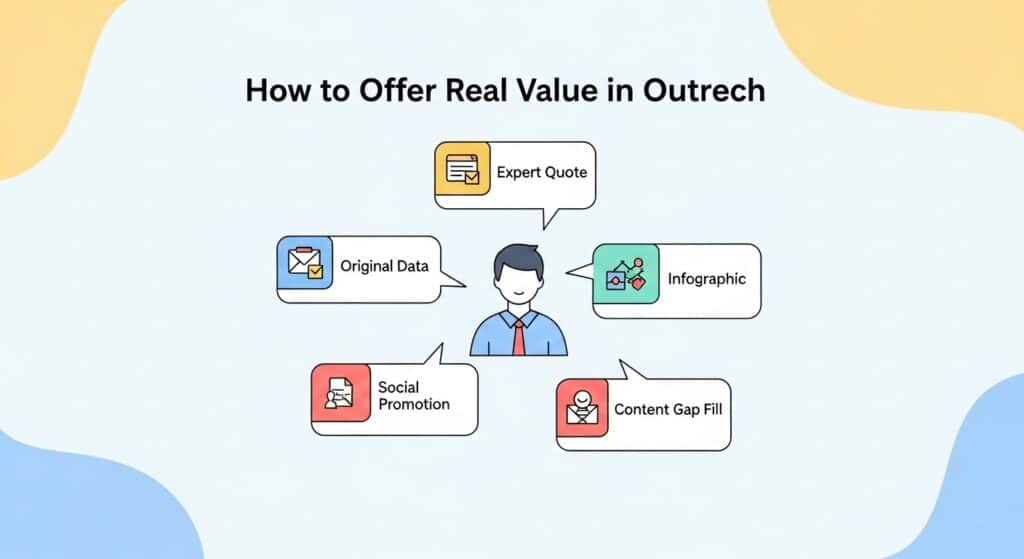
To build a focused outreach list:
- Search Google using inurl:blog plus your niche keyword
- Analyze competitors’ backlink profiles for placement ideas
- Use Semrush to verify organic traffic and topical relevance
- Check blog freshness and engagement before pitching
Topical alignment builds more than rankings. It builds trust. When your links come from within your industry, they tell Google your content belongs at the top.
2. Personalize Your Outreach Emails
Personalized outreach emails consistently outperform templates, increasing response rates by up to 50%. Mass-sending the same pitch to every blog owner no longer works. Take time to research the person behind the blog, not just the site.
Start by visiting their About page, LinkedIn profile, or X/Twitter handle. Address them by their actual name. Study their writing style, values, and previous content. This helps you write messages that feel genuine, not generic.
Instead of pushing your own agenda, focus on mutual value. Suggest a guest post idea tailored to their readers. Reference a recent post they wrote and explain why you appreciated it. These small touches signal respect—and often lead to better replies.
Tips for effective personalization:
- Use their first name or social handle, not “Hi there”
- Mention a specific article they wrote and why it stood out
- Suggest a content idea that fills a gap in their current blog
- Keep it under 200 words for quick readability
- End with a friendly, clear CTA (like a question or soft ask)
📧 Sample Personalized Outreach Email
Subject: Loved your post on [Topic] — Quick Collab Idea
Hi [Name],
I just finished your post on “[Blog Title],” and your take on [specific idea] really stood out. I run content strategy at [Your Brand], and we often cover similar topics.
I’d love to contribute a guest post idea:
“[Proposed Title]” — focused on [brief value description].
Would this be of interest? Happy to send a short brief.
Cheers,
[Your Name]
[LinkedIn or Website link]
3. Offer Value Beyond the Backlink
To earn high-quality backlinks, you must offer something valuable in return. In blogger outreach, your pitch should improve the blogger’s content or bring value to their audience. This creates a reason to link back to you naturally.
Instead of just asking for a link, contribute something useful. Bloggers are more likely to say yes when your offer helps them grow, build authority, or engage readers.
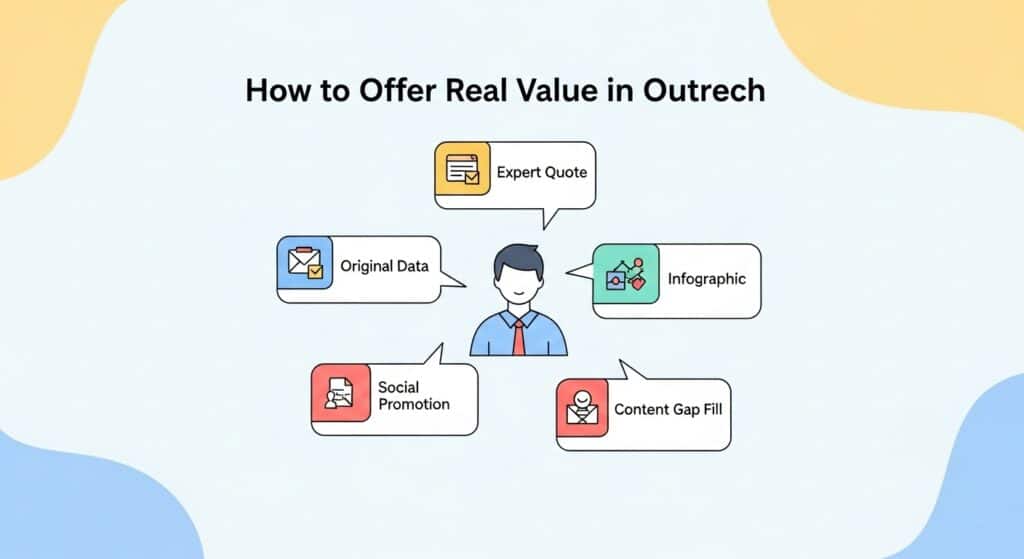
The best outreach feels like a collaboration, not a cold request. It builds trust and increases your approval rate.
At T-RANKS, we take a value-first approach by always offering something helpful—like data, visuals, or promotional support. In our experience, this strategy leads to around 30% more link acceptances compared to generic requests.
Ways to add value in your outreach:
- Share original data or recent industry research
- Offer a brief expert quote or insight
- Create a custom visual like an infographic
- Promote their blog on your social media
- Pitch a guest post that fills a content gap
4. Focus on Editorial Standards
Editorial standards determine if your pitch gets accepted. Every blog has its own voice, formatting rules, and expectations for quality. Even great content gets rejected if it doesn’t match the site’s tone or structure.
Before you pitch, take time to understand what the blog actually publishes. Editors look for content that blends naturally with their existing posts and adds value to their audience. Meeting these standards increases your chances of getting published and earning a backlink.
To increase your approval rate:
- Read 3 to 5 recent posts from the blog to understand their style, voice, and structure
- Check for published contributor guidelines and follow them exactly, including link policy and formatting instructions
- Avoid promotional content. Focus on helpful insights, tutorials, or case studies that serve the blog’s audience
- Back up key points with data or reputable sources, especially when making claims or giving advice
- Match the article’s structure—use similar word count, subheadings, and flow for a natural fit
Content that aligns with a blog’s editorial voice builds credibility and trust. Review your draft from the perspective of the site’s editor. Would they publish it without major edits? If not, rework it before sending.
Pro tip: Run your final draft through a grammar tool and read it aloud. This catches awkward phrasing and ensures clarity.
5. Avoid Mass Outreach Automation
Automated outreach puts your domain at risk. In 2025, Google’s link spam detection is sharper than ever. Bulk emails with identical templates are easy to spot and often land in spam folders.
As we know, many automation tools exist—but you can’t let the process run on autopilot. If you want replies, you need to clear two key hurdles: first, getting past spam filters and into the recipient’s inbox. Second, writing an email compelling enough to capture attention and get read. That’s why outreach must combine automation for speed with manual personalization for success.
Follow these steps to stay effective and compliant:
- Vet each blog manually to ensure niche relevance and quality
- Avoid copy-paste templates. Customize every email with specifics
- Track your outreach in a CRM or spreadsheet to manage follow-ups
- Use different subject lines and intros to reduce spam risk
- Study each recipient’s site or profile before reaching out
In our experience, campaigns that use a value-first, personalized approach generate 3–5 times more replies than automated blasts—especially in competitive niches.
Request a Custom Blogger Outreach Campaign with T-RANKS
In our experience, campaigns that use a value-first, personalized approach generate 3–5 times more replies than automated blasts—especially in competitive niches.
Request a Custom Blogger Outreach Campaign with T-RANKS
6. Leverage Guest Post Contributions
Guest posting is one of the most effective ways to earn high-quality, editorial backlinks through blogger outreach. These links are niche-relevant and often placed within trusted, high-authority content.
To make guest posting work, focus on value. Pitch well-written articles tailored to the blogger’s audience, not just content that benefits your site. If your pitch feels helpful, it’s more likely to be accepted.
In our experience at T-RANKS, building real connections with bloggers increases guest post success rates. Once trust is established, many site owners are open to contributions or even sponsored placements. While payment can be part of the process, it usually comes after you’ve built rapport and shown editorial quality.
If your pitch doesn’t land organically, offering a small incentive may help—but only when the relationship is already established and the blog has editorial control.
Practical tips to improve guest post outreach:
- Pitch two or three relevant, timely topics based on the blog’s niche
- Add original insights, visuals, or expert contributions to your draft
- Place links naturally within the content—not in bios or footers
- Follow the site’s tone, style, and submission guidelines closely
- Reference past guest contributions to show credibility
Focus first on offering value, not getting a link. When your content fits the blog and helps its audience, backlinks come as a natural result.
7. Track Performance with UTM Tags
Tracking your blogger outreach helps measure real SEO impact not just link placement. Without tracking, you won’t know which blogs are sending qualified traffic or which links are contributing to conversions.
How can you measure blogger outreach performance? Add UTM parameters to each backlink before it goes live. These tags work with tools like Google Analytics 4 to show exactly where your traffic comes from and what users do after landing on your site.
To track link performance effectively:
- Create unique UTM tags for each blog (source, medium, campaign)
- Use GA4 to monitor referral traffic and on-site behavior
- Set up conversion goals like form fills or product purchases
- Visualize trends using Looker Studio dashboards
- Identify high-performing blogs to prioritize in future campaigns
Many SEOs overlook this step, but tracking reveals which outreach efforts are actually driving ROI. Over time, you’ll spot which placements boost visibility and which ones underperform. This lets you refine your strategy with data instead of assumptions.
8. Build Long-Term Relationships
Blogger outreach becomes far more effective when you focus on long-term relationships instead of one-off placements. One email can get you a backlink. A real connection can bring you links, mentions, and collaborations for years.
Most failed outreach campaigns overlook this. Bloggers receive hundreds of cold pitches every week. To stand out, you need to offer consistency, support, and value—even when you’re not asking for something.
How can you build relationships that turn into long-term backlink opportunities?
- Engage publicly: Leave thoughtful comments on their blog or social media posts
- Support them first: Share their content and tag them where appropriate
- Follow up consistently: Send a thank-you after a successful placement and stay in touch
- Pitch value, not just content: Suggest joint interviews, expert roundups, or custom insights
- Offer new ideas over time: Reconnect every few months with fresh angles or useful updates
We’ve seen this approach repeatedly outperform cold pitches. Bloggers trust those who help, not just those who ask. Treat outreach like building your network—not just collecting links.
H3: 9. Filter Low-Value Blogs
Low-quality blogs can harm your SEO more than help it. That’s why careful filtering is critical in every outreach campaign. Google’s link spam systems are smarter in 2025, and irrelevant or suspicious backlinks may get ignored—or even trigger penalties.
Before you pitch, ask: Is this blog safe, active, and relevant?
Here’s how to identify red flags:
- Spam score above 10% (check with Moz or tools like Semrush)
- Inactive blog with no recent posts
- No clear editorial standards or poor content quality
- Thin backlink profile with mostly spammy or irrelevant links
- Link placement on unrelated, off-topic pages
- Too many dofollow outbound links, especially to random sites
To find quality blogs, start with competitor analysis. Look at where your top 10 competitors are getting backlinks. Are those blogs niche-relevant? Do they have organic traffic? This gives you a benchmark.
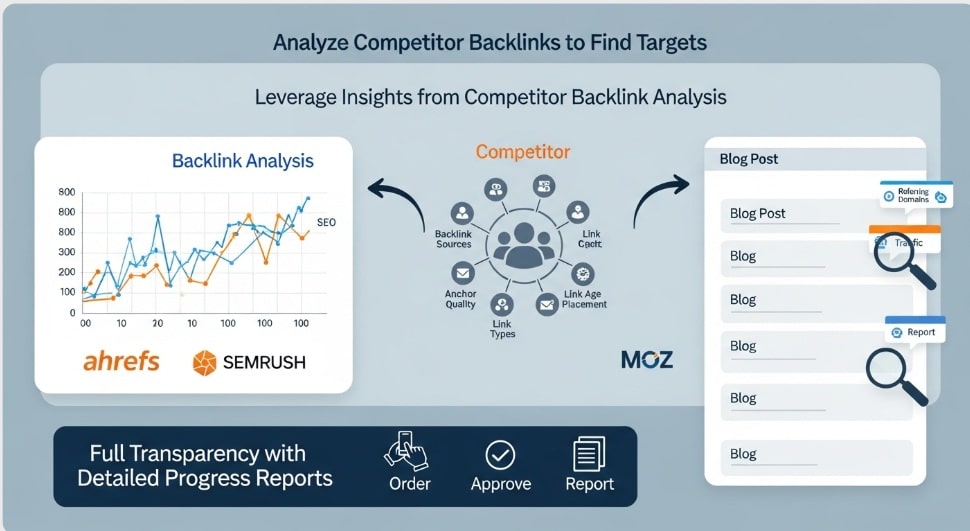
Also verify:
- Organic traffic using Semrush or SimilarWeb
- Fresh content updates (last post within 30–60 days)
- Comments or social engagement to confirm real audience
- Site purpose—avoid blogs that exist only to sell links
Manual filtering takes time, but it protects your SEO in the long run. Focus on relevance, activity, and editorial integrity. A single link from a clean, trusted blog is worth more than ten from spammy ones.
10. Use a Trusted Blogger Outreach Service
Scaling blogger outreach is resource-intensive. A professional outreach service can help you earn quality backlinks faster—without compromising SEO integrity.
If you’re juggling multiple niches or don’t have time for personalized pitching, outsourcing makes sense. Manual outreach, blog vetting, and follow-ups are all time-consuming tasks. A reliable service removes that burden while keeping your backlink profile safe.
Here’s what to expect from a good blogger outreach provider:
- Access to vetted, niche-relevant blogs with real traffic
- Manual, personalized outreach—not automated spam
- Quality content aligned with each blog’s tone and editorial policy
- Clear reporting and live tracking of link placements
- Custom pitch options with controlled anchor text strategy
The key is to choose a provider that follows white-hat outreach practices. This ensures your links comply with Google’s guidelines and support long-term SEO performance.
Need help scaling your link building?
Common Blogger Outreach Mistakes to Avoid
Blogger outreach delivers results only when done with precision. Many SEO professionals make small but critical errors that block replies, reduce link quality, or even trigger penalties.
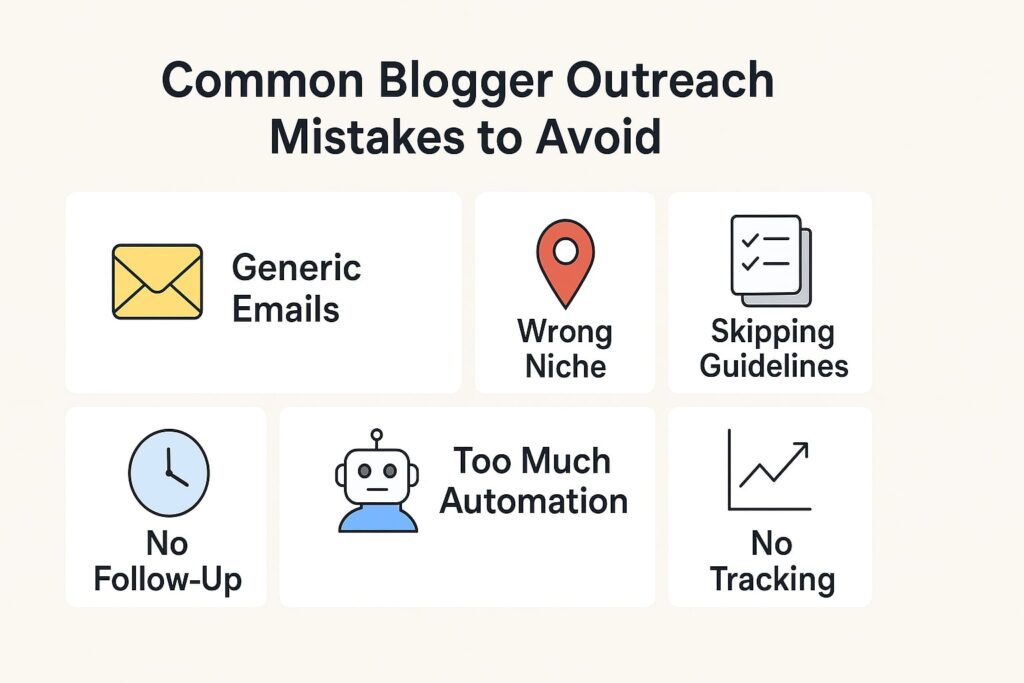
If you want your campaigns to succeed in 2025, start by avoiding the most common outreach pitfalls. Here’s what to watch for.
Reaching Out Without Research
If you pitch a blog without understanding its content, tone, or target audience, you’re starting on the wrong foot. Bloggers can easily tell when an email is generic or irrelevant. Study the blog’s latest posts, About page, and even social media before you send anything.
Targeting the Wrong Niche
Niche relevance is one of the strongest SEO signals. A backlink from an unrelated blog may look good in a report but carries little real value. Instead, study your top 10 competitors and identify where they’re getting links. This helps you find blogs that pass topical authority.
Ignoring Blogger Guidelines
Most bloggers share clear contributor or guest posting guidelines. If you fail to follow them whether it’s word count, formatting, or topic restrictions, you’ll likely be rejected. These instructions exist for a reason. Respecting them shows professionalism and increases approval chances.
Sending Generic Pitches
Mass emailing is easy, but ineffective. Bloggers can spot a template in seconds. Instead, personalize your emails by mentioning the blogger’s name, referencing a specific article, and showing you’ve done your homework. This small effort dramatically increases reply rates.
Only Thinking About Your Own Goals
Outreach isn’t about getting what you want—it’s about offering value. If your pitch focuses only on your brand, traffic, or product, bloggers won’t be interested. Show how your content helps their audience. Make it a win-win, not a one-sided request.
Skipping the Introduction
Jumping into a link request without any context is a fast way to get ignored. Introduce yourself properly. Say who you are, why you’re reaching out, and how your idea fits their blog. A simple, human opening builds trust and increases engagement.
Failing to Build Relationships
Cold outreach can work, but warm outreach works better. Engage with the blogger before pitching. Leave thoughtful comments, share their posts, or mention them in your own content. This builds familiarity, making your email feel less like a cold pitch and more like a conversation.
Relying Too Much on Automation
Email tools can streamline the process, but full automation usually backfires. Spam filters catch mass emails. Bloggers ignore robotic templates. Use tools to manage follow-ups or track responses—but write each pitch manually. Human contact is what earns backlinks.
Not Sending Follow-Ups
Even great emails get buried. If you don’t follow up, you miss second chances. A polite reminder, 3–5 days later, can double your chances of getting a reply. Keep it short, friendly, and relevant to your original pitch.
Forgetting to Track Results
Without tracking, you can’t know what’s working. Add UTM tags to each link you place. Use GA4 or Looker Studio to measure traffic, conversions, and engagement. These insights help you refine your outreach strategy over time and justify ROI to stakeholders.
Final Thoughts: Is Blogger Outreach Right for You?
Blogger outreach is still one of the safest and most effective ways to earn high-quality backlinks in 2025. It builds real authority by securing links through relevance, trust, and manual relationship-building.
If you follow a personalized, value-first approach, blogger outreach not only helps you rank higher but also builds lasting connections in your niche. It aligns with Google’s E-E-A-T standards, avoids risky link schemes, and scales with your brand’s growth.
But success takes time. You need research, strategic outreach, and consistency. If you’re not ready to commit to the full process, results will stay limited.
At T-RANKS, we specialize in manual blogger outreach campaigns that deliver backlinks with real SEO value. Whether you’re targeting a niche site or scaling outreach across multiple industries, our experts can help.
Ready to earn links that boost rankings and trust? Talk to our outreach team today
FAQs About Blogger Outreach
What is a blogger outreach service?
A blogger outreach service connects you with relevant blog owners to help you earn backlinks through content collaboration. These services manage prospecting, pitching, and follow-ups to secure placements that improve your SEO.
Does blogger outreach help SEO in 2025?
Yes, blogger outreach improves SEO by earning natural, niche-relevant backlinks. These links boost domain authority, increase trust signals, and support Google’s E-E-A-T guidelines.
Is blogger outreach still effective after Google’s 2024 spam update?
Yes, when done manually with high-quality blogs, it remains safe and effective. The key is avoiding automated link schemes and focusing on real editorial placements.
How long does a blogger outreach campaign take?
Most campaigns take 2 to 4 weeks to complete. This includes finding prospects, crafting pitches, and securing live backlinks.
What types of blogs should I target for backlinks?
Target blogs that are niche-relevant, have active traffic, and maintain editorial standards. Relevance is more important than just high DA.
Can blogger outreach be scaled across multiple industries?
Yes, blogger outreach can scale with the right network, pitch templates, and outreach systems. It’s effective for SaaS, ecommerce, local businesses, and more.
How do I know if a blog is worth pitching?
Check for traffic, content freshness, engagement, and low spam scores. Tools like Ahrefs, Moz, and SimilarWeb help verify site quality.
Do I need to pay for every guest post placement?
No, many placements can be earned by offering value like unique content or original data. However, in some niches, payment may be required if the blog has strict editorial control or high demand.
What happens if I use automation for blogger outreach?
Overusing automation increases your risk of spam flags and lower reply rates. It also violates Google’s guidelines if used to send mass, generic pitches.
Can Google detect paid guest post backlinks?
Yes, if links appear unnatural or come from known networks, Google’s algorithms may flag them. Focus on relevance, quality content, and proper disclosure when needed.
What’s the ROI of blogger outreach compared to other link building methods?
Blogger outreach offers high ROI due to long-term SEO value, referral traffic, and brand visibility. It typically outperforms paid directory links or low-quality edits.
Should I track my blogger outreach results?
Yes, tracking with UTM tags and Google Analytics helps measure referral traffic, conversions, and campaign effectiveness. It’s essential for optimizing future outreach.

